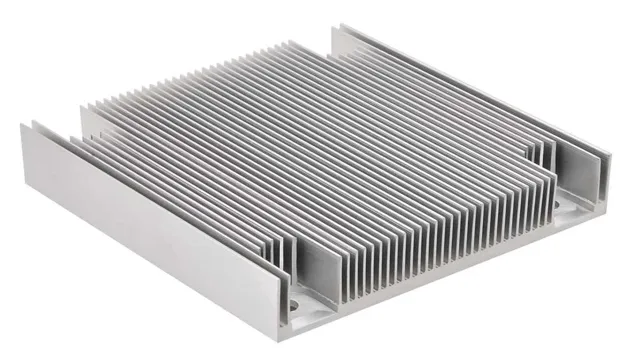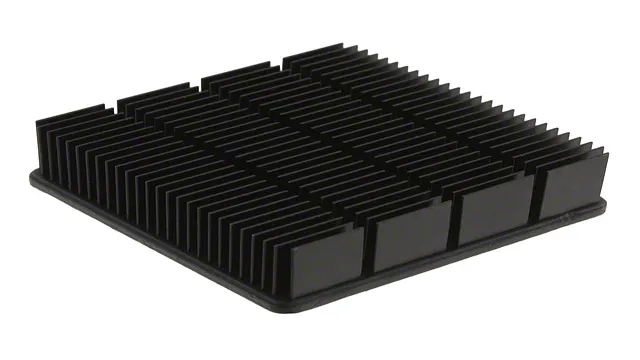If you’re building a high-performance PC, you’re definitely considering an M.2 NVMe drive. These solid-state drives (SSDs) have revolutionized storage with their blazing fast read and write speeds.
But as you shop around for M.2 drives, you may have come across some with heat sinks attached. At this point, you’re probably wondering – do M.
2 drives need heat sinks? M.2 NVMe drives generate a lot of heat, which can affect their performance and lifespan. Heat sinks are generally used to dissipate this heat, keeping the drive cool and running smoothly.
However, whether or not you need a heat sink depends on your specific use case. For most users, a heat sink isn’t necessary. If you’re using your M.
2 NVMe drive for standard desktop use – gaming, web browsing, etc. – you’ll likely be fine without one. But if you plan on doing heavy file transfers or running the drive at maximum capacity for extended periods of time, you may want to consider a heat sink to keep it cool.
Ultimately, the decision of whether or not to use a heat sink on your M.2 NVMe drive is up to you. If you’re building a high-performance PC and want to squeeze every bit of performance from it, a heat sink may be worth the investment.
What are M2 Drives?
M2 drives are solid-state drives that connect to your computer through an M.2 slot on the motherboard. They are known for their speed and performance, with reading and writing speeds that can far surpass traditional hard drives.
As for the question of whether M2 drives need heat sinks, it depends on usage. While high-performance drives may generate a significant amount of heat, not all M2 drives require a heat sink. Some models come with built-in heat sinks, while others may not need extra cooling depending on usage.
If you plan on using your M2 drive for demanding tasks such as video rendering or gaming, it’s wise to invest in a heat sink to prevent it from overheating. However, for everyday use such as web browsing and basic productivity tasks, a heat sink may not be necessary. Overall, it’s important to consider the use of your M2 drive and the level of performance you require before deciding whether a heat sink is necessary.
Definition and Types
M2 drives are an advanced type of solid-state drive (SSD) that are designed to work with the M.2 interface on a motherboard. They provide better performance and speed compared to traditional storage devices like hard disk drives (HDDs) and SATA SSDs.
M2 drives come in different types, including SATA-based, PCI Express-based, and NVMe-based. SATA-based M2 drives are similar to traditional SATA SSDs while the NVMe-based ones are the fastest, providing lightning-fast read and write speeds that are ideal for gaming and other high-end applications. M2 drives are small in size and can fit easily in laptops and other compact devices, making them a popular choice for gamers and other professionals who require fast and reliable storage performance.

Read and Write Speeds
M.2 drives, also known as Next Generation Form Factor (NGFF) drives, are a type of solid-state drive (SSD) that use the M.2 interface to connect to a motherboard.
These drives come in different sizes, with the most common being 22x80mm, and offer high read and write speeds compared to traditional hard disk drives. M.2 drives use the latest NAND flash memory technology and typically offer sequential read and write speeds of up to 3,500/3,000MB/s.
They are well-suited for gamers, content creators, and any other users who need faster data transfer rates, faster boot times, and shorter application loading times. M.2 drives are also ideal for small form factor builds as they are small in size and do not require any cables or power connectors.
Overall, M.2 drives are a great upgrade option for anyone looking to speed up their computer’s performance.
Pros and Cons of Heat Sinks
M2 drives are the latest generation of solid-state drives, and they use the NVMe protocol for super-fast data transfer rates. While M2 drives are generally cooler and more efficient than other types of storage, they are still vulnerable to overheating under heavy loads. This is where heat sinks come in – they help to dissipate the heat generated by the drive and prevent it from causing damage.
However, there are also some cons to using heat sinks. For one, they can add extra bulk and cost to your build. Additionally, some heat sinks may interfere with the installation of other components and require extra attention during installation.
Ultimately, whether or not your M2 drive needs a heat sink will depend on your specific use case and the type of workload you plan to run.
Pros
When it comes to electronic devices, heat is a common issue that must be addressed to ensure optimal performance and longevity. This is where heat sinks come into play as they help dissipate heat away from the device. One of the primary advantages of using heat sinks is that they offer an affordable and efficient solution to manage heat.
They’re also easy to install and can work in a variety of environments. Additionally, heat sinks come in many different shapes and sizes to fit the specific needs of different electronic components. Another advantage of heat sinks is that they are a passive cooling system, which means they don’t require any maintenance or power source to function.
Overall, when used correctly, heat sinks can be an excellent way to manage heat and increase the lifespan and reliability of electronic devices.
Cons
When it comes to heat sinks, there are both pros and cons to consider. On the pro side, a heat sink can effectively dissipate heat generated by electronic components, preventing them from overheating and causing damage. This can lead to improved performance and increased lifespan of the electronic device.
Additionally, heat sinks are relatively inexpensive and easy to install, making them a popular choice for cooling solutions. However, there are also a few cons to using heat sinks. One issue is that they typically require a fan or other type of airflow to be effective.
Without proper airflow, a heat sink can quickly become overwhelmed and fail to provide adequate cooling. Another drawback is that heat sinks can be bulky and take up valuable space, potentially making them unsuitable for smaller electronic devices. Additionally, some heat sinks may require periodic maintenance, such as cleaning or reapplication of thermal paste, which can be time-consuming and inconvenient.
Overall, heat sinks can be a useful tool for managing heat in electronic devices, but it’s important to consider the potential drawbacks before deciding to use one. When properly installed and maintained, a heat sink can be an effective and affordable cooling solution. However, alternative methods of cooling may be necessary in certain situations, so it’s important to carefully evaluate all options before making a decision.
Heat Sink Compatibility
M2 drives, also known as NVMe SSDs, are known to offer faster speeds and better performance compared to traditional hard drives. However, with higher speeds comes higher temperatures, especially during heavy workloads or prolonged usage. This is where heat sinks come into play.
Although they are not mandatory, heat sinks can aid in dissipating heat generated by M2 drives and prevent overheating, which can ultimately lead to reduced performance and even failure of the drive. While not all M2 drives require heat sinks, it is recommended to invest in one for optimal performance and longevity of your NVMe SSD. So, in short, do M2 drives need heat sinks? While it’s not a necessity, it is highly recommended to invest in one to ensure your drive remains cool under pressure and continues to perform at its best.
Motherboards with Heat Sinks
When it comes to building a powerful computer, one of the most important components is the motherboard. However, not all motherboards are created equal, and some come with heat sinks while others do not. Heat sinks are important because they help to dissipate heat from the motherboard, which can prolong its lifespan and prevent overheating.
It is important to check the compatibility of the heat sink with the motherboard before making a purchase. Some motherboards may have specific requirements for the size or type of heat sink that can be used. Additionally, some heat sinks may require a specific mounting mechanism or have compatibility issues with certain processors or graphics cards.
Taking the time to research and find the right heat sink for your motherboard can make all the difference when it comes to the performance and longevity of your computer. So, if you want to ensure that your motherboard is running at its best, it is worth considering a motherboard with a compatible heat sink.
Effect on Performance
Heat sink compatibility can have a significant impact on the performance of a computer system. Heat sinks play a crucial role in regulating the temperature of critical components like CPUs and GPUs, which can affect their efficiency and lifespan. When choosing a heat sink, it’s essential to ensure that it is compatible with the specific CPU or GPU model that you are using.
A heat sink that is not compatible may not fit properly or provide adequate cooling, which can result in overheating and reduced performance. It’s also important to consider the size and design of the heat sink and whether it will fit within your computer case. Choosing the right heat sink can ensure that your computer runs smoothly and effectively, without any overheating or performance issues.
So, if you’re building a new computer or upgrading your existing one, make sure to choose a heat sink that is fully compatible with your components.
Conclusion
In summary, while it’s not absolutely necessary for M.2 drives to have heat sinks, they do offer added benefits in terms of maintaining performance and durability. Plus, let’s be honest, who wouldn’t want a sleek and stylish heat sink attached to their high-performance storage device? So go ahead, add some heat sinks to your M.
2 drives, because as we all know, cooler is always better.”
FAQs
What is an M.2 drive and how does it work?
An M.2 drive is a type of solid-state drive that connects directly to the motherboard through an M.2 slot. It uses high-speed PCIe or SATA connections to transfer data quickly.
Do all M.2 drives require a heat sink?
No, not all M.2 drives require a heat sink. Some M.2 drives come with a built-in heat spreader, while others do not generate enough heat to require one.
How do I know if my M.2 drive needs a heat sink?
You can monitor the temperature of your M.2 drive using software like CrystalDiskInfo or HWMonitor. If it consistently runs at a temperature above 60 degrees Celsius, you may need to install a heat sink.
Can I install a third-party heat sink on my M.2 drive?
Yes, you can install a third-party heat sink on your M.2 drive, as long as it is compatible with the size and type of the drive. Some M.2 drives have different key or length configurations, so make sure to check the specifications before purchasing a heat sink.
